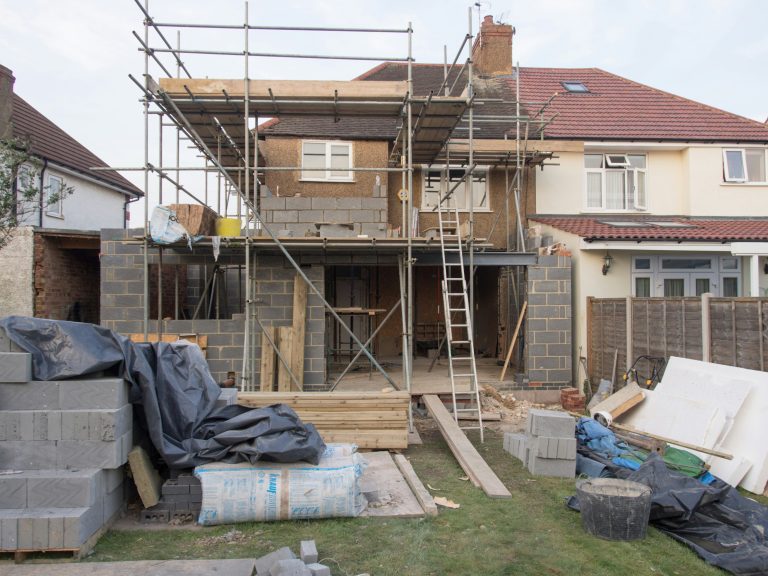Building a home extension is easy to dream about and can be somewhat trickier to plan.
Add in finding out what kind of budget you need and can afford, and it’s not unusual to feel swamped by information.
That’s where we come in — to take it away from the intimidating part, pound by pound. Don’t worry, we’re not going to waffle on with weaselly designer-speak, either. We’re here to give you the straight British stuff on home extensions, what you can get for your budget, and how you can make the most of every last quid.
So, let’s get to it.
Before We Start — Just How Much Extension Are We Talking?
Home extensions in the UK can cost anywhere from £1,500 per square metre to £3,500+, depending on location, type, size, and (always) quality of build.
The range is pretty broad, we know. Home extensions are a big ask, so there will be quite a spread in what you can expect to spend.
The first ballpark number we’ll start with here is £20,000, which is certainly a decent place to start but also not really all that much. You could go further with £20k if you were prepared to do a lot of the work yourself. But, with that budget, you’re not building a monument. More of a nice-to-have play space.
Flip the other end of the scale, and £100,000 feels like big money but is actually what we’d class as a mid-range figure for a build like this.
What really matters, though, is what you can actually get for it. With that in mind, let’s have a quick gander at some of the basic options.
£20,000–£30,000
We’re not going to lie, it’s not much in the grand scheme of things, but hey, we’ll start here. With a budget at this level, you’re looking at a basic single-storey extension that’s roughly 3×3 metres.
It sounds tight, but even at that size, it opens up a number of possibilities, such as:
- A utility room (finally sort out where that washing machine should go!)
- A snug home office or reading room
- A downstairs toilet (a big game changer if you’ve got kids)
You’ll need to keep things simple, though. Forget pricey finishes, skylights, and underfloor heating—it’s not in the budget. But simple doesn’t have to be plain. With a neat layout, good lighting, and some clever storage, it’ll still add valuable life to your home.
An alternative at this price point is a conservatory or orangery. They’ll typically cost you less per square metre than a brick extension (quick maths — £20,000 is 1/4 of £80,000, so you can have a conservatory that’s 4 times as big!) and often take less time to build, too.
Have a peek at Conservatory Online Prices to get a better feel for what a conservatory costs and what a similar budget could get you. It’s a great place to start and will help give you an idea of costs and some inspiration for what you could do with the space: https://www.conservatoryonlineprices.co.uk/conservatory-prices/
£40,000–£60,000
Things start to get more exciting with a budget in this range. We’re talking a larger single-storey extension this time that’s around 4×5 metres. Still not huge, but enough to really make a difference to how your home works.
Popular options in this price bracket include:
- A beautiful open-plan kitchen-diner with space for a sofa and TV area
- A large playroom or family room
- A proper home office setup (bye-bye kitchen table Zooming)
At this price, you can also afford to add some extras — maybe a skylight or roof lantern, underfloor heating, and potentially bi-fold doors to look out on to the garden.
The danger with this budget (and it’s a real danger), is that you’ll spend more on “little” extras than you realise. A tile sample here, a pendant light there… before you know it, you’ve splashed out £1,200 on “features” and don’t have enough left for flooring.
The key is to be aware of this. Don’t let it put you off, but do think carefully, work to a plan, and keep a close eye on costs if you want to hit your budget.
£70,000–£100,000
Right, now you’re talking. At this level, a double-storey extension is definitely on the cards. We’re not only adding onto the downstairs but also tacking on a new bedroom/bathroom/office etc. above.
Options include:
- A huge kitchen/living/dining area downstairs
- A new master suite upstairs (en-suite if you budget smart)
- Or two smaller bedrooms upstairs for the kids/guests/lodger
This level of spend also allows you to play with finishes a bit more. Fancy some brushed brass taps? OK. A feature wall of reclaimed wood? Sure. Just don’t neglect the basics like insulation, electrics, and plumbing. You can splash on the looks — but not on the things you can’t see.
Planning permission will come into it here, depending on the size and use of the new build (more on that later). But, either way, building regs always apply. Build it legally.
Over £100,000
Either you’re planning a serious addition or you’ve been filming for the next series of Grand Designs. Let’s start with the former.
Possibilities with a budget like this include:
- Wraparound extensions
- Full refurbishment alongside the build
- Basement conversions or loft overhauls
- Luxe garden rooms with plumbing and heating
OK, just because you can splash the cash doesn’t mean you will or should. Costs can spiral if you lose control, so have a good plan and some flexibility if you’re to make the most of this kind of budget.
What Else You Need to Think About
There are some other expenses that can easily be missed. So, before you get too carried away with bubble diagrams for that breakfast bar, bear in mind that you’ll need to allow for:
- Professional fees for architects, surveyors, planning consultants, etc.
- Permissions, if needed, for planning, building regs, party walls
- Finishes for flooring, tiling, fixtures, lighting, etc.
- Landscaping, as your lovely new extension will make the rest of your garden look like a building site.
Want to Keep Costs Down? Read This Bit Twice
So, OK. The honest truth is that home extensions don’t have to cost the earth. But, you’ve got to be smart about it.
Design for simplicity. Rectangles and squares are cheaper to build than L or U shapes, etc. Keep plumbing close to existing pipes and positionings to save on the cost of rerouting. And for goodness sake, don’t move the boiler unless you have to. It’s an absolute money pit.
Find a good builder. Get three quotes or more. See examples of previous work. Don’t go with the cheapest. They can cost you more in the long run.
DIY what you can. Paint walls, hang shelves, tile a bathroom (if you’re brave). These are easy ways to shave a few hundred off the final bill. Just don’t overreach — there’s no shame in asking for help where needed.
Use reclaimed materials. Salvage what you can from other sources. A huge market exists on Facebook Marketplace, building supply auctions, salvage yards, etc. that are ripe for the foraging homeowner.
Final Thoughts
In the end, is it all worth it?
Yes, we think so. Done well, a home extension isn’t just about adding square metres. It’s about adding life to your home, more space, more comfort, more room to breathe. If you’re in the market to move, it’s often a better option to stay and improve than to face the cost, hassle, and uncertainty of a relocation.
So, sure, there’s stress involved, the garden will look like a building site for a while, and the builders will probably drink all your tea.
But, once it’s done, when you’re standing in your new kitchen, sipping a cuppa and enjoying the difference, you’ll know it’ll all have been worth it.
What next? Get a tape measure and a notepad. Make a quick sketch. Think about what would really make your home better, not just different. Then ask questions, crunch some numbers, and start getting excited.
This isn’t just an extension. It’s your next chapter.


